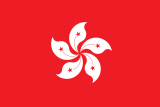Portal:Hong Kong/Selected article/2006
These articles have appeared on the Portal:Hong Kong page in 2006 since the creation of the portal. They are (or were at the time of listing) Featured Articles or from the list of selected article.
July

Mass Transit Railway or MTR (地下鐵路, literally "underground railway"; usually abbreviated to 地鐵 or 地下鐵) is the main rapid transit railway system in Hong Kong. Since the MTR service first opened in 1979, the network has expanded to encompass seven lines and 53 stations along 91.0 km [1]. Constructed and operated by MTR Corporation Limited, the MTR system is a very popular mode of public transport in Hong Kong, with an average of 2.46 million[2] journeys recorded each day.
Much of this popularity is due to the efficiency and affordability of the MTR. For example, a taxi ride from Tsing Yi in the New Territories to Causeway Bay on Hong Kong Island costs around HK$200, while the same trip on the MTR costs HK$11.80, and HK$5.70 on concessionary fare.[3] The integration of the Octopus contactless smart card system into the MTR system in September 1997 has particularly enhanced the ease of use of the MTR.
Construction of the MTR was prompted by a government-commissioned study released in 1967. The Hong Kong Government commissioned the study in the 1960s to find solutions to the growing traffic problem caused by expansion of the colony's economy.[4] Construction started soon after release of the study, and the first line was opened in 1979. The MTR was immediately popular with the residents of Hong Kong, and as a result subsequent lines have been built to cover more territory. There are continuing debates as to how and where to expand the MTR network, including new lines and a possible merger with Kowloon-Canton Railway Corporation to create a combined network. (Read more...)
This article was the Selected Article from April 2005 to July 2006.
References
- ^ "Mass Transit Railway", Transport Department (Hong Kong Government), retrieved 16 March 2006
- ^ "MTR Patronage Figures for February 2006", MTR Corporation Limited, retrieved 16 March 2006
- ^ Based on "MTR Journey Planner", MTR Corporation Limited, retrieved 16 March 2006.
- ^ Freeman, Fox, Wilbur Smith & Associates (1967), Hong Kong Mass Transport Study, as shown in map above mentioned.
August

The Bank of China (Hong Kong) (BOCHK, 中國銀行(香港)) (SEHK: 2388) is the second-largest commercial banking group in Hong Kong in terms of assets and customer deposits, with more than 300 branches in Hong Kong. It was established on October 1, 2001 from a merger of 12 subsidiaries and associates of the Bank of China in Hong Kong, and listed on the Hong Kong Stock Exchange in October 2002. As of the end of 2003, the bank had HK$763 billion in assets and earned net profit of HK$8 billion in 2003.
BOCHK is one of the three banks which issue banknotes for Hong Kong, the biggest member and a founder of the JETCO ATM and payment system, and the designated clearing bank in Hong Kong for transactions involving the renminbi, Mainland China's currency. It is legally separate from its parent, Bank of China (BOC), although they maintain close relations in management and administration and cooperate in several areas including reselling BOC's insurance and securities services. It also shares its Hong Kong headquarters, the Bank of China Tower, with its parent; completed in 1988, this was the first building outside of North America to exceed 1,000 feet. (Read more...)
September

The Regional flag of the Hong Kong Special Administrative Region of the People's Republic of China (Traditional Chinese: 中華人民共和國香港特別行政區區旗, Simplified Chinese: 中华人民共和国香港特别行政区区旗) features a stylised, white, five-petal Bauhinia blakeana in the centre of a red field. The red colour on this flag coincides with the flag of the People's Republic of China.
The flag of Hong Kong was adopted on 16 February 1990, and received formal approval from the Preparatory Committee on 10 August 1996. The flag was first officially hoisted on 1 July 1997, in a historical ceremony marking the transfer of sovereignty from the United Kingdom to the PRC. The precise use of the flag is regulated through laws passed by the 58th executive meeting of the State Council held in Beijing.
The former colonial flag was used from 27 July 1959, to 30 June 1997, when Hong Kong was under British rule. It was a blue Union Jack ensign with the Emblem of Hong Kong on a white disk centred on the outer half of the flag. The 1876 design featured a colonial badge, showing a "local scene" instead of the Hong Kong coat of arms. (Read more...)
October
Hong Kong action cinema is the principal source of the Hong Kong film industry's global fame. It combines elements from the action movie, as codified by Hollywood, with Chinese storytelling and aesthetic traditions, to create a culturally distinctive form that nevertheless has a wide transcultural appeal. In recent years, the flow has reversed somewhat, with American and European action films being heavily influenced by Hong Kong genre conventions.
The first Hong Kong action films favoured the wuxia style, emphasizing mysticism and swordplay, but this trend was politically suppressed in the 1930s and replaced by styles in which films depicted more down-to-earth unarmed kung fu, often featuring folk hero Wong Fei Hung. Post-war cultural upheavals led to a second wave of wuxia films with highly acrobatic violence, followed by the emergence of the grittier kung fu films for which the Shaw Brothers studio became best known. The 1970s saw the rise and sudden death of international superstar Bruce Lee. He was succeeded in the 1980s by Jackie Chan—who popularised the use of comedy, dangerous stunts, and modern urban settings in action films—and Jet Li, whose authentic wushu skills appealed to both eastern and western audiences. The innovative work of directors and producers like Tsui Hark and John Woo introduced further variety (for example, gunplay, triads and the supernatural). An exodus by many leading figures to Hollywood in the 1990s coincided with a downturn in the industry. (Read more...)
November
Ngong Ping 360 is a tourism project in Lantau Island, New Territories, Hong Kong, consists of the Ngong Ping Skyrail cable car system and Ngong Ping Village. It is owned by the MTR Corporation, built and operated by Skyrail-ITM. The project was previously known as Tung Chung Cable Car Project before branded as such in April 2005.
Ngong Ping Skyrail is a 5.7km long cable car system linking between Tung Chung (where it connects the MTR Tung Chung station) and Ngong Ping (where the Po Lin Monastery and Tian Tan Buddha are located). Between the two terminals at Tung Chung and Ngong Ping, the cable cars run across the southern shore of the Hong Kong International Airport island and the Nei Lak Shan, with eight towers including the stations.
The Skyrail was originally scheduled to open on 24 June 2006. However, due to the incident on June 17, 2006, (see the Incident section for details), Skyrail-ITM announced to postpone the opening day to fix the technical problems. After 2 months of improvement works and repair for the damages made by Typhoon Prapiroon in August 2006, Ngong Ping 360 resumed a trial-run of 7 days from 30 August 2006. It was opened on 18 September 2006. However, there have already been several reports of technical problems, some of them caused by strong winds.
The Ngong Ping Village is built next to the Skyrail Ngong Ping Terminal, occupies a 15,000 square metre site and has been designed to mirror and uphold the cultural and spiritual veracity of the Ngong Ping area. Traditional Chinese architectural designs are a feature of the Ngong Ping Village, which contains an assortment of shopping and dining experiences, on top of a number of key attractions counting Walking With Buddha, the Monkey's Tale Theatre and the Ngong Ping Tea House. (Read more...)
December

The Hong Kong Special Administrative Region of the People's Republic of China (Chinese: 中華人民共和國香港特別行政區 [pronunciation]) is one of the two special administrative regions (SARs) of the People's Republic of China (PRC), the other being Macau. It is commonly known as Hong Kong (Chinese: 香港), which is often written Hongkong in older English-language texts. The Hong Kong Government officially changed the name of Hongkong to Hong Kong on 3 September 1926.[1]
Hong Kong is on the eastern side of the Pearl River Delta on the southeastern coast of the People's Republic of China, facing the South China Sea in the south, and bordering Guangdong Province in the north. Hong Kong has one of the world's most liberal economies and is a major international centre of finance and trade. Hong Kong is China's richest region in terms of GDP per capita and gross metropolitan product figures.
Hong Kong was a British colony from 1842, until its sovereignty was transferred to the PRC in 1997. It is governed as a special administrative region under the Basic Law of Hong Kong. Under the terms of the Sino-British Joint Declaration, the PRC has promised that Hong Kong will have a relatively high degree of autonomy until at least 2047, fifty years after the transfer of sovereignty. Under the "One Country, Two Systems" policy, it retains its own legal system, currency, customs policy, cultural delegation, international sport teams, and immigration laws, with the PRC representing Hong Kong diplomatically and militarily. (Read more...)
References
- ^ Hongkong Government Gazette, Notification 479, 3 September 1926
